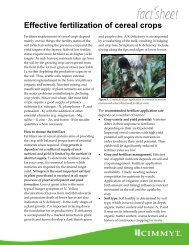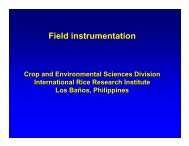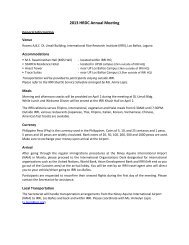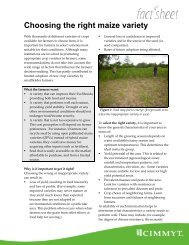Ecosystem services andthe environment44.1 Ecosystem servicesAlthough the ma<strong>in</strong> function of <strong>rice</strong> fields is toproduce <strong>rice</strong>, they also provide a range of other“ecosystem services” (also referred to as “multifunctionality”)(Bouman et al 2006a). Ecosystemservices can be grouped <strong>in</strong>to the follow<strong>in</strong>g categories(Millennium Ecosystem Assessment 2005): Provision<strong>in</strong>g (e.g., fresh water and commoditiessuch as food, wood, timber, and fuel) Regulat<strong>in</strong>g (e.g., water purification, and climateand flood regulat<strong>in</strong>g) Support<strong>in</strong>g (e.g., nutrient cycl<strong>in</strong>g, soil formation,primary production) Cultural (e.g., aesthetic, spiritual, educational,recreational)The most important provision<strong>in</strong>g function of<strong>rice</strong> environments is, of course, the production of<strong>rice</strong>. Examples of other provision<strong>in</strong>g services arethe rais<strong>in</strong>g of fish and ducks <strong>in</strong> <strong>rice</strong> fields, ponds, orcanals. Frogs and snails are collected for consumption<strong>in</strong> some countries.As part of regulat<strong>in</strong>g services, bunded <strong>rice</strong>fields may <strong>in</strong>crease the water storage capacity ofcatchments and river bas<strong>in</strong>s, lower the peak flowof rivers, and <strong>in</strong>crease groundwater flow. For example,<strong>in</strong> 1999 and 2000, 20% of the floodwater<strong>in</strong> the lower Mekong River Bas<strong>in</strong> was estimated tobe temporarily stored <strong>in</strong> upstream <strong>rice</strong> fields (Masumoto2004). Other possible regulatory services ofbunded <strong>rice</strong> fields and terraces <strong>in</strong>clude the preventionor mitigation of land subsidence, soil erosion,and landslides (PAWEES 2005). Percolat<strong>in</strong>g waterfrom <strong>rice</strong> fields, canals, and storage reservoirsrecharges groundwater systems (Mitsuno 1982).The moderation of air temperature by <strong>rice</strong> fieldshas been recognized as an important function <strong>in</strong>peri-urban areas where <strong>rice</strong> fields and urban land are<strong>in</strong>term<strong>in</strong>gled (Oue 1994). This function is attributedto relatively high evapotranspiration rates result<strong>in</strong>g<strong>in</strong> reduced ambient temperature of the surround<strong>in</strong>garea <strong>in</strong> summer, and <strong>in</strong> lateral heat emissionfrom the water body <strong>in</strong> w<strong>in</strong>ter. <strong>Rice</strong> can be usedas a desal<strong>in</strong>ization crop because the cont<strong>in</strong>uouslypercolat<strong>in</strong>g water (Chapter 1.3) leaches salts fromthe topsoil (Bhumbla and Abrol 1978). The leachateshould be removed by a good dra<strong>in</strong>age system, orelse there is risk for <strong>in</strong>creased sal<strong>in</strong>ization of thegroundwater. <strong>Rice</strong> soils that are flooded for longperiods of the year contribute to the mitigation ofthe greenhouse effect by tak<strong>in</strong>g CO 2from the atmosphereand sequester<strong>in</strong>g the carbon (C) (Bronson1997a, Dobermann 2003).As a support<strong>in</strong>g service, flooded <strong>rice</strong> fields andirrigation channels form a comprehensive waternetwork, which, together with the contiguous dryland, provides a complex mosaic of landscapes. Irrigated<strong>rice</strong> land has been classified as human-madewetlands by the Ramsar Convention on Wetlands(Ramsar 2004). Surveys show that such landscapessusta<strong>in</strong> a rich biodiversity, <strong>in</strong>clud<strong>in</strong>g unique aswell as threatened species, and also enhance biodiversity<strong>in</strong> urban and peri-urban areas (Fernandoet al 2005).The cultural services of <strong>rice</strong> fields are especiallyvalued <strong>in</strong> Asian countries where, for centuries,<strong>rice</strong> has been the ma<strong>in</strong> staple food and thes<strong>in</strong>gle most important source of employment and<strong>in</strong>come for rural people. Many old k<strong>in</strong>gdoms aswell as small communities have been founded onthe construction of irrigation facilities to stabilize<strong>rice</strong> production. <strong>Rice</strong> affects daily life <strong>in</strong> many waysand the social concept of <strong>rice</strong> culture gives mean<strong>in</strong>gto <strong>rice</strong> beyond its role as an item of production and35
consumption (Hamilton 2003). Many traditionalfestivals and religious practices are associated with<strong>rice</strong> cultivation and <strong>rice</strong> fields are valued for theirscenic beauty.4.2 Environmental impactsThe production of lowland <strong>rice</strong> affects the environment<strong>in</strong> negative ways, such as the emissionof greenhouse gases and water pollution. In thissection, environmental impacts that have a relationshipwith water and the hydrology of <strong>rice</strong> fields aresummarized.4.2.1 Ammonia volatilizationAmmonia (NH 3) volatilization from urea fertilizeris the major pathway of N loss <strong>in</strong> tropical flooded<strong>rice</strong> fields, often caus<strong>in</strong>g losses of 50% or more ofthe applied urea-N (Buresh and De Datta 1990).Ammonia-N emissions from lowland <strong>rice</strong> fields areestimated to be roughly 3.6 Tg per year (comparedwith a total of 9 Tg y −1 emitted from all agriculturalfields), which is some 5−8% of the estimated 45−75Tg of globally emitted ammonia-N per year (Kirk2004). The magnitude of ammonia volatilizationlargely depends on climatic conditions, field waterstatus, and the method of N fertilizer application.Volatilized ammonium can be deposited on theearth by ra<strong>in</strong>, which can lead to soil acidification(Kirk 2004) and un<strong>in</strong>tended N <strong>in</strong>puts <strong>in</strong>to naturalecosystems.4.2.2 Greenhouse gasesIrrigated <strong>rice</strong> systems are a significant s<strong>in</strong>k for atmosphericCO 2(Chapter 4.1), a significant sourceof methane (CH 4), and a small source of nitrousoxide (N 2O). In the early 1980s, it was estimatedthat lowland <strong>rice</strong> fields emitted some 50−100 Tgof methane per year, or about 10−20% of the thenestimated global methane emissions (Kirk 2004).Recent measurements, however, show that many<strong>rice</strong> fields emit substantially less than those <strong>in</strong>vestigated<strong>in</strong> the early 1980s, especially <strong>in</strong> northern Indiaand Ch<strong>in</strong>a. Also, methane emissions have actuallydecreased s<strong>in</strong>ce the early 1980s because of changes<strong>in</strong> crop <strong>management</strong> such as a decreased use oforganic <strong>in</strong>puts (Van der Gon et al 2000). Currentestimates of annual methane emissions from <strong>rice</strong>fields are <strong>in</strong> the range of 20 to 60 Tg, be<strong>in</strong>g 5–10%of total global emissions of about 600 Tg (Kirk2004). The magnitude of methane emissions from<strong>rice</strong> fields is ma<strong>in</strong>ly determ<strong>in</strong>ed by water regime andorganic <strong>in</strong>puts, and to a lesser extent by soil type,weather, tillage, residue <strong>management</strong>, fertilizer use,and <strong>rice</strong> cultivar (Bronson et al 1997a,b, Wassmannet al 2000). Flood<strong>in</strong>g of the soil is a prerequisitefor susta<strong>in</strong>ed emissions of methane. Mid-seasondra<strong>in</strong>age, a common irrigation practice adopted <strong>in</strong>major <strong>rice</strong>-grow<strong>in</strong>g regions <strong>in</strong> Ch<strong>in</strong>a and Japan,greatly reduces methane emissions. Similarly,<strong>rice</strong> environments with an uneven supply of water(for example, those suffer<strong>in</strong>g from water scarcity,Chapter 1.7) have a lower emission potential thanfully <strong>irrigated</strong> <strong>rice</strong>.Few accurate assessments have been made ofemissions of nitrous oxide from <strong>rice</strong> fields (Abao etal 2000, Bronson et al 1997a,b, Dittert et al 2002),and the contribution to global emissions has not yetbeen assessed. In <strong>irrigated</strong> <strong>rice</strong> systems with goodwater control, nitrous oxide emissions are quitesmall except when excessively high fertilizer-Nrates are applied. In <strong>irrigated</strong> <strong>rice</strong> fields, nitrousoxide emissions ma<strong>in</strong>ly occur dur<strong>in</strong>g fallow periodsand immediately after flood<strong>in</strong>g of the soil at the endof the fallow period.4.2.3 <strong>Water</strong> pollutionChanges <strong>in</strong> water quality associated with <strong>rice</strong> productionmay be positive or negative, depend<strong>in</strong>gma<strong>in</strong>ly on <strong>management</strong> practices such as fertilizationand biocide (all chemicals used for crop protection,such as herbicides, pesticides, fungicides, etc.)use. The quality of the water leav<strong>in</strong>g <strong>rice</strong> fields maybe improved as a result of the capacity of the <strong>rice</strong>fields to remove nitrogen and phosphorus (Feng etal 2004, Ikeda and Watanabe 2002). On the otherhand, nitrogen transfer from flooded <strong>rice</strong> fields bydirect flow of dissolved nitrogen through runoffwarrants more attention. High nitrogen pollutionof surface fresh waters can be found <strong>in</strong> <strong>rice</strong>-grow<strong>in</strong>gregions where fertilizer rates are excessivelyhigh, such as <strong>in</strong> Jiangsu Prov<strong>in</strong>ce <strong>in</strong> Ch<strong>in</strong>a (Cuiet al 2000).Contam<strong>in</strong>ation of groundwater may arisefrom the leach<strong>in</strong>g of nitrate or biocides and theirresidues (Bouman et al 2002). Nitrate leach<strong>in</strong>gfrom flooded <strong>rice</strong> fields is quite negligible becauseof rapid denitrification under anaerobic conditions(Buresh and De Datta 1990). For example, <strong>in</strong> thePhilipp<strong>in</strong>es, nitrate pollution of groundwater under<strong>rice</strong>-based cropp<strong>in</strong>g systems surpassed the 10 mgL −1 limit for safe dr<strong>in</strong>k<strong>in</strong>g water only when highly36
- Page 2: Water Management in Irrigated Rice:
- Page 5 and 6: PrefaceWorldwide, about 79 million
- Page 8 and 9: Fig. 1.2. Water balance of a lowlan
- Page 10 and 11: given in Table 1.1. Water losses by
- Page 14 and 15: Distribution (%)1009080706050403020
- Page 16 and 17: The plant-soil-water system22.1 Wat
- Page 18 and 19: Ψ Air-100 MPaDemandLeafXylemStemRo
- Page 20: tive to water deficit than cell enl
- Page 23 and 24: Water input (mm)4003503002502001501
- Page 25 and 26: Table 3.1b. Yield, water input, and
- Page 27: Grain yield (t ha -1 )98A2002 20037
- Page 30 and 31: Table 3.5. Water input (I = irrigat
- Page 32 and 33: Practical implementationTemperate e
- Page 34 and 35: Practical implementationSpecific in
- Page 36 and 37: Table 3.8. Comparison of water use
- Page 38: Flooded yield (t ha -1 )87A65432102
- Page 44 and 45: Irrigation systems55.1 Water flows
- Page 46 and 47: the main system is supply-driven, f
- Page 48 and 49: Table 5.1. Area, water use, and tot
- Page 50 and 51: Appendix: InstrumentationDetailed d
- Page 52: 0.5 cm in diameter and spaced 2 cm
- Page 55 and 56: Bronson KF, Singh U, Neue HU, Abao
- Page 57 and 58: Lampayan RM, Bouman BAM, De Dios JL
- Page 59: Uphoff N. 2007. Agroecological alte





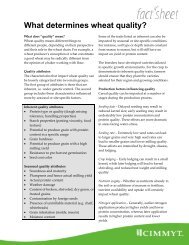

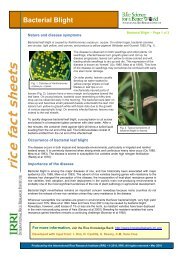

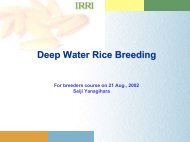
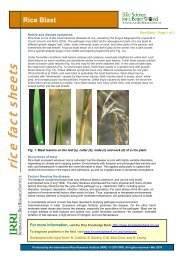
![International Standards' Organization â Rice Specification [ISO 7301]](https://img.yumpu.com/36696862/1/190x245/international-standards-organization-a-rice-specification-iso-7301.jpg?quality=85)

